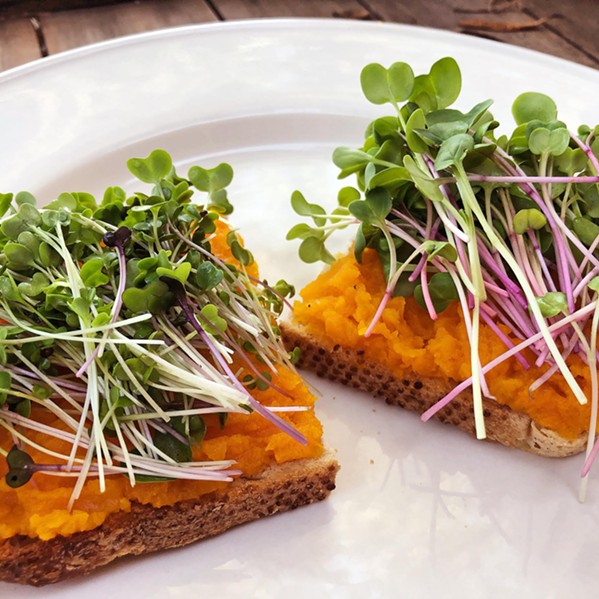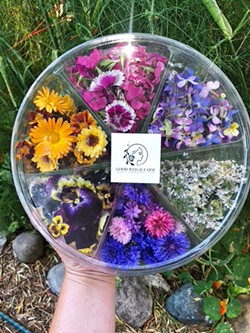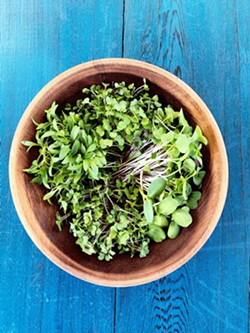Often forgotten about until it's time to make a plate of food look pretty, microgreens and edible garnishes are at the forefront of Lompoc cultivator Jane Darrah's mind.
"I found microgreens because I was looking for longevity foods. So, this was five-plus years ago before microgreens were cool and a thing ... on the mainstream level, anyway," Darrah told New Times on March 22. "I started growing them for myself, and then I was growing other vegetables that had produced some flowers."

- Photos Courtesy Of Jane Darrah
- WHOLE FOOD Good Witch Farm's founder Jane Darrah encourages microgreens to be used as more than just scant garnish—just like these radish microgreens paired with mashed sweet potatoes on sourdough.
The founder of Good Witch Farm—a cheeky reference to her Halloween birthday—Darrah dug into the world of high-quality microgreens and flowers to boost her failing immune system. She had burned herself out after spending years as a social worker on an assertive community treatment team and as a Court Appointed Special Advocates volunteer.
"I saw basically how food impacted these people directly on the front line, that they didn't have proper nutrition," she said. "I really came to understand how important healthy fruits and vegetables and just a connection with actual ground became in one's healing and one's recovery journey."

- Photos Courtesy Of Jane Darrah
- FLOWER WHEEL Good Witch Farm grows a plethora of edible flowers like pansies, violas, hollyhocks, calendula, borage, yarrow, carnations, and dianthus.
Darrah eventually dusted off her skill set as a former Future Farmers of America member, tapped YouTube for research, and flexed her natural gift of having a green thumb to create her microgreen-exclusive business Good Witch Farm. Since 2019—first out of a hoop house in her mom's backyard and eventually out of one on her own property in Lompoc—she's grown more than 20 varieties of microgreens like broccoli, kale, sunflower, radish, pea, basil, dill, parsley, nasturtium, arugula, and onion. Her 40-foot-long and 12-foot-wide hoop house hosts a cornucopia of edible flowers, too, like fennel flowers, mustard flowers, pansies, violas, hollyhocks, calendula, borage, yarrow, carnations, and dianthus.
Growing microgreens is a delicate, labor-intensive process. They must be grown inside the hoop house, protected from outdoor exposure, and constantly touched up to deal with fluctuating weather patterns. Darrah grows her microgreens and flowers without the help of fluorescent lighting for the most part and makes sure to use nutrient-rich soils and top-grade seeds.
She doesn't depend on herbicides and pesticides either, which means she fights off pests like aphids, moths, and snails by herself. How does she do that? Darrah just picks them up and moves them.
"They're my worst enemy!" she joked. "I never thought I'd hate an animal ever, but I do not enjoy snails."
Darrah likens the growing process to babysitting because microgreens are, essentially, baby vegetable and herb plants.
To be considered microgreens, these plants must be collected before they reach the cotyledon stage, which is typically between zero and 12 days or up to 17 days with some varieties. Once harvested at such a young age, they—with the exception of pea plants and sometimes nasturtium—immediately die, prompting replacement.
"True microgreens do not have a center leaf, they just have two of the first baby leaves," Darrah said. "The reason you want to eat microgreens at this stage is because ... the science is telling us right now ... that one of those tiny little baby stems has anywhere between four and 40 times the nutritional value of the plant at maturity."
She credited the nutrient-dense food as helping to improving her immune system, and now Darrah delivers her microgreens and flowers to restaurants throughout San Luis Obispo County. The bulk of her clients are in Paso Robles, and she's hoping to gain more clients in Santa Barbara County too. A couple of times a week, she loops through the Santa Ynez Valley, all the way to Paso Robles and back, making stops at caterers and restaurants like In Bloom, Pair with Chef Rachel, Les Petite Canailles, Parrish Family Vineyard, First & Oak, and Pony Espresso.

- Photos Courtesy Of Jane Darrah
- GREEN BUNDLES Good Witch Farm founder Jane Darrah credits microgreens for boosting her immunity and offers varieties like broccoli, kale, sunflower, radish, pea, basil, dill, parsley, nasturtium, arugula, and onion.
"One of the things I love about that the most is they utilize their microgreens as food instead of just a garnish. That's kind of what I was always about," Darrah said. "So, now it's really cool to see how the market has shifted ... and Pony Espresso's always been on that page."
Good Witch Farm is coming out of the usual sluggish demand period from November to March. Spring orders are climbing while harvest season is around the corner. During peak busy seasons, Darrah said she's dropped between 16 and 25 deliveries a day, and 90 ounces of microgreens twice a week to some clients.
"Borage is always a hit, and all the chefs love cilantro microgreens, I swear to God," she said with a laugh. "The onion microgreens are really a favorite."
Currently, Good Witch Farm's products are only available to purchase wholesale, which is why restaurants are its major buyers. Darrah originally had plans to connect with a distributor to get her microgreens out in stores.
"But the truth is that you're seeing the quality of food programs because the way that they are packaged, you have to meet certain weight marks, and because of the logistics of distribution, they just sit and they go through different temperature fluctuations," she said. "It's really not a product, in my opinion, that handles that super, super well and for that extended period of time."
That distribution reality made her change her goal, compelling her to stick with restaurants and pursue direct-to-consumer avenues like working with the Community Supported Agriculture network and local farm stands.
Though Good Witch Farm's client base includes Michelin-rated restaurants, accessibility across the socio-economic scale is important to Darrah. She sells her microgreens to a Lompoc-based mobile farmers market truck called Route One. The truck then sells it to customers at fair prices and also accepts electronic benefit transfer (EBT) cards issued by programs like CalFresh, formerly known as Food Stamps.
"My goal is to work with other organizations that get food to people that struggle with food insecurity and people that are on food stamps," Darrah said. "I really think that impacts people's recovery and wellness, and of course, that just changes the whole dynamic of our community as a whole." Δ
Staff Writer Bulbul Rajagopal is waiting to eat edible flowers in Lompoc. Send more mileage to [email protected].
Comments